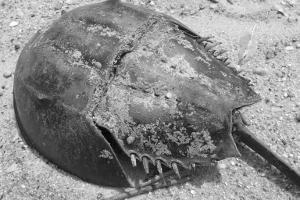The Incredible Horseshoe Crab
- posted: Jun. 30, 2015

Horseshoe Crab Blood Used to Identify Bacterial Contaminants in Drugs
It’s officially summer and, for many of us, that means a trip to the beach. Since we are so close to the Delmarva Peninsula, it is a common vacation destination for York County residents and these Atlantic beaches are also residence to many horseshoe crabs.
Why am I talking about horseshoe crabs? Truth is I have always found the prehistoric-looking critters fascinating, but even more so after learning about their unique immune systems. Horseshoe crabs have survived virtually unchanged for over 400 million years. One of the reasons they have been around for so long, is the way they stave off infections. They do not have white blood cells like mammals, but instead they have cells called amoebocytes that release a chemical into their bloodstream causing a clot to form around and wall off any bacteria. Incidentally, horseshoe crabs have blue blood thanks to copper compounds in their bloodstream.
Even more remarkable than the blue color, is the use of the chemical in their blood known as limulus amoboecyte lysate--or LAL for short—in human and veterinary medicine. LAL has been in use since the 1970’s to detect extremely small amounts of bacterial endotoxins that may contaminate drugs, vaccines or medical devices such as prosthetics or implants. Just like when bacteria enter the crab’s bloodstream and cause a clot to form, a drop of LAL will cause a contaminated substance to gel or coagulate.
Each year, horseshoe crabs are captured to collect their blood so LAL can be used in a variety of medical tests. After donating up to 30% of their blood, they are released back to the ocean.
They may not be much to look at, but the horseshoe crab with its armored shell and spiky tail provides us with a unique and reliable way to keep our drugs and vaccines safe from bacterial contamination. Who knows what other medical secretes they may hold? So, if you come across any horseshoe crabs at the beach this summer, take a moment to ponder the amazing bacteria-fighting blue blood that courses through their veins!
This blog brought to you by the Patton Veterinary Hospital, serving Red Lion, York and the surrounding areas.
Information taken from the Spring 2015 edition of Watermarks magazine published by the National Aquarium in Baltimore, MD.
Location
Patton Veterinary Hospital
425 E Broadway
Red Lion, PA 17356
